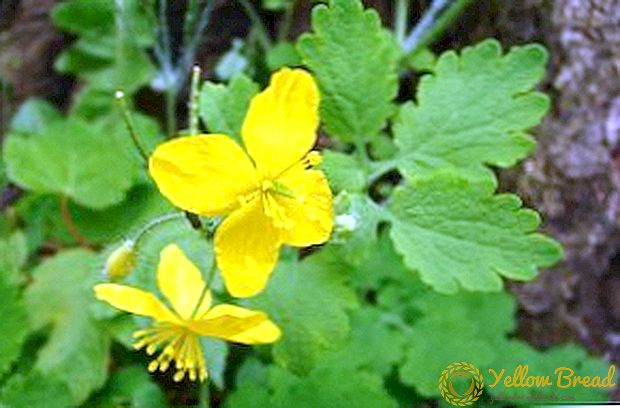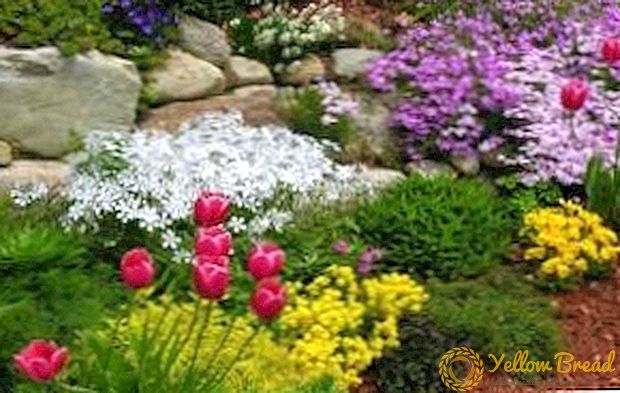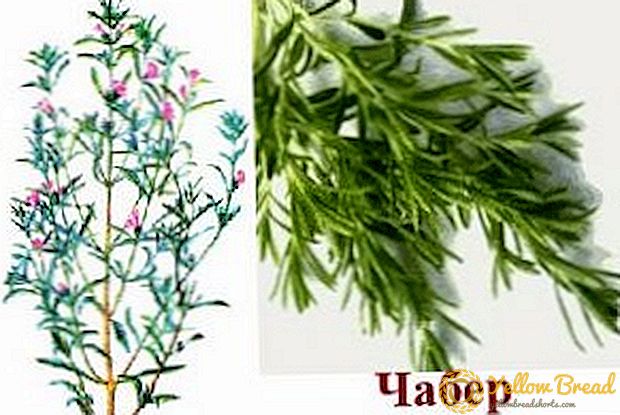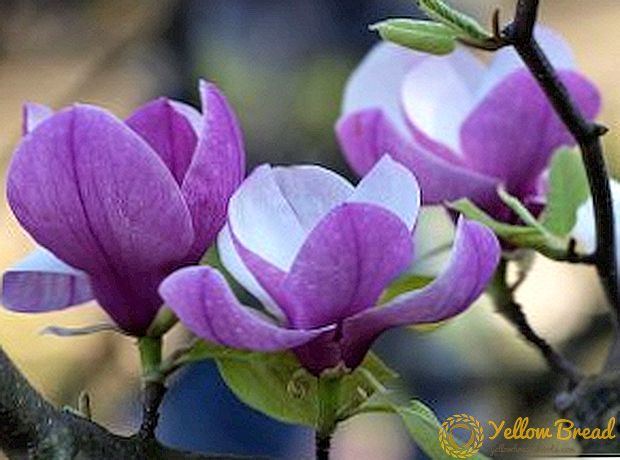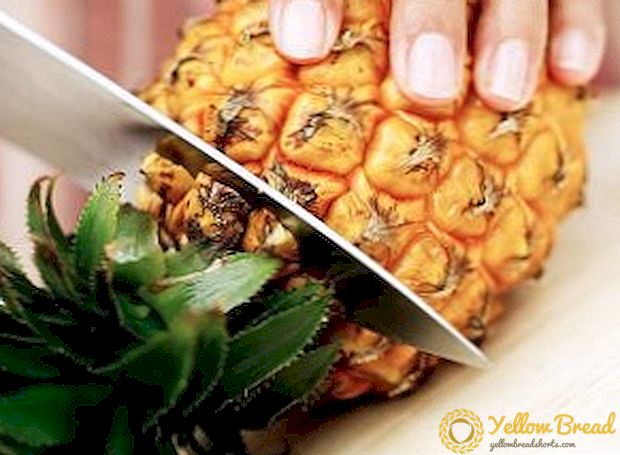 A pineapple - This amazing tropical plant hails from the tropics of South America. In Europe, it began to grow in greenhouses, creating the necessary climate conditions.
A pineapple - This amazing tropical plant hails from the tropics of South America. In Europe, it began to grow in greenhouses, creating the necessary climate conditions.
But with an effort, growing pineapple can be done even at home. And after a while this interesting plant will amaze us with its appearance and fruits.
- Pineapple: Plant Description
- What conditions does pineapple need for successful growth?
- Lighting
- Air temperature and humidity
- How to plant a pineapple
- Pineapple Care Rules
- Do I need to water the pineapple?
- Top dressing of an exotic plant
- Secrets of the successful flowering of pineapple
- How to deal with pests and diseases of pineapple
- How to propagate pineapple
Pineapple: plant description
A pineapple - it is a herbaceous plant with a stem in its center. In the center of the stem, at the top - inflorescence, which after fertilization turns into fertility.
Outwardly, it can be seen that separate parts of the seed berries grow together into one fruit - pineapple. The stem is surrounded by a rosette - fleshy and thick leaves.
Pineapple fruit has an oval, cylindrical shape, consists of numerous numerous small parts fused together.At the top there is a rosette of leaves.
 The dense scaly shell of a ripe fruit has a dark green, yellow, brown or even reddish tint. Inside the fruit - bright yellow flesh. It has a pleasant taste and good aroma. The ripened fruits of pineapple reach a weight of 4-5 kg.
The dense scaly shell of a ripe fruit has a dark green, yellow, brown or even reddish tint. Inside the fruit - bright yellow flesh. It has a pleasant taste and good aroma. The ripened fruits of pineapple reach a weight of 4-5 kg.
What conditions does pineapple need for successful growth?
Pineapple, when grown at home, is very picky about the conditions that will be created for its successful ripening. Since it is a tropical plant, it is extremely important to maintain proper lighting, temperature and humidity.
Lighting
Pineapple must be at least 6 hours a day, regardless of the time of year, be in a well-lit place. In summer, the plant can be taken out on the balcony or in the garden, in a moderately lit place. In the cold season, the pineapple must be kept on the south side, in order to obtain even sunlight.
The plant should not be rotated, because it can slow growth, it is enough and one-sided lighting. If the time of year and weather conditions do not allow to ensure the ingress of sunlight, then the pineapple can be highlighted with additional lighting - fluorescent lamps. Only it is worth considering that when using lamps pineapple should receive coverage of at least 8 hours a day.
Air temperature and humidity
 Pineapple is very afraid of the cold. If in the summer it is quite satisfied with the ambient temperature, then in the winter time it is worthwhile to foresee ways of preserving heat in the room and the soil of the plant. It should not be kept on a cold floor or windowsill, in winter it is best to keep the soil temperature between 18 and 21 ° C, the maximum temperature for the winter period is 27 ° C.
Pineapple is very afraid of the cold. If in the summer it is quite satisfied with the ambient temperature, then in the winter time it is worthwhile to foresee ways of preserving heat in the room and the soil of the plant. It should not be kept on a cold floor or windowsill, in winter it is best to keep the soil temperature between 18 and 21 ° C, the maximum temperature for the winter period is 27 ° C.
The plant should not be kept near the batteries and heaters, it is also necessary to provide no drafts. To maintain moisture, you must use a pot with wet drainage. You can spray the water around the plant, the leaves should not be sprayed, as water can accumulate inside the outlet and cause them to rot. They should be wiped from dust with a damp cloth.
How to plant a pineapple
Before you plant a pineapple at home, it is worth getting a ripe, fresh and healthy fruit for a start.
A good pineapple fruit should:
- Have a light sweet aroma.
- Have no external damage, the color should be uniform, golden brown.
- To the touch pineapple should be elastic. If the fruit is soft, then this means that it is overripe. If the fruit is hard, then, on the contrary, immature.
- The leaves at the top must be fresh, green with slightly dried edges - this is an important sign of the maturity of the fruit. If there are gray spots, it means that the leaves are damaged by the insects, and the use of such a fruit should be discarded.
Observing the following rules, we will be able to grow a good pineapple at home, which will delight us with its unusual look and will bear fruit in the future.
The separation of the tufts of the fetus
To separate the crown of leaves from pineapple can be quite simple. You need to wrap all the leaves with your hand and turn it very carefully, as if unscrewing the bottle cap. If everything worked out correctly, you should have in your hand a crown of leaves with a small stem below.
 If you are worried that you may not be able to do everything carefully, you should use a knife. Knife need to cut off the top crown of pineapple and cut out the whole pulp to prevent rotting.
If you are worried that you may not be able to do everything carefully, you should use a knife. Knife need to cut off the top crown of pineapple and cut out the whole pulp to prevent rotting.
Preparation of the crown for root germination
It is necessary to remove a few lower leaves with a knife to expose the trunk, from which we will grow roots.After pruning the leaves and cleaning the trunk, leave our future pineapple to dry for a couple of days to prevent the scars and leaves from rotting after pruning.
Then the dried crown should be placed in a transparent dish with water so that it covers the bare trunk of our plant. Water should be at room temperature. Place the dishes in a bright place on the windowsill. It is necessary to closely monitor the water level, periodically changing the water. If done correctly, pineapple will take root in 3 - 4 weeks.
Planting pineapple in the ground
After the roots have grown 3-4 cm, pineapple can be planted in the ground. For the primary planting it is better to use a small pot with a hole for water flow, suitable in size to our crown. At the bottom of the pot stack 3-centimeter layer of drainage, you can use expanded clay.
It is necessary to fill a pot with the friable, nutritious earth. After backfilling, it is recommended to pour hot water into the ground. After that, you can land our plant. You need to plant 5-6 cm deep, after planting it is good to pour the pineapple with warm water. You need to put the plant in a bright and warm place. Pineapple rooted for 2-3 months.
In the future, the first leaves will wither and die off, but in their place new green shoots will begin to grow. Old leaves need to be carefully cut and removed. Grown pineapple is watered once a week with warm water. After a year of growth, the pineapple is again transplanted into a larger pot.
You still need to put a drainage layer on the bottom, this time you can use gravel. Soil should be used from a mixture of two parts of peat, one part of river sand and three parts of natural soil. In winter, the growth of pineapple slows down, but you should not worry: with the onset of the warm period, it will begin to grow abundantly, only for this you will need to feed the soil.
Pineapple Care Rules
Watching our pineapple grow at home, we see that pineapple is a very thermophilic plant. It should be watered, but water should be prevented from stagnating.It also needs periodic top dressing of the soil.
Do I need to water the pineapple?
 The soil in the pot with pineapple should not dry out, but the water should not stagnate. Therefore, an adult plant should be plentifully watered once a week with warm water.
The soil in the pot with pineapple should not dry out, but the water should not stagnate. Therefore, an adult plant should be plentifully watered once a week with warm water.
If the plant is outdoors, then its leaves should be sprayed: they will absorb moisture, and the rest will evaporate. During the period of active growth, watering pineapple can be changed: water twice a week, but reduce the amount of water poured. It is best when the water passes through the drainage completely and flows out.
If there is a swamp smell in the pot or mold appears on the soil, then it should be replaced as soon as possible, otherwise the plant may die.
Top dressing of an exotic plant
During the growing season, pineapple needs to be fed twice a month. A good fertilizer will be ordinary cow humus. You can also make a complex of mineral fertilizers, which are sold in garden stores, but the dosage should be reduced by half, compared with other plants.
It is also necessary to spray the plant once a month with a 0.01% solution of ferrous sulfate. Alkaline fertilizers, lime and wood ash are not recommended for pineapple.
Secrets of the successful flowering of pineapple
 In the natural environment, in order for the pineapple to blossom, it will take 26 months. At home, flowering time may vary in different directions. When 16 months have passed, and the plant height will be more than 20 cm, you can count on the beginning of flowering. Pineapple blossoms according to the following description.
In the natural environment, in order for the pineapple to blossom, it will take 26 months. At home, flowering time may vary in different directions. When 16 months have passed, and the plant height will be more than 20 cm, you can count on the beginning of flowering. Pineapple blossoms according to the following description.
At the top of the trunk, a bud begins to form, it gradually rises upward on the stem that grows from the stem. A couple of months begins flowering and lasts literally two weeks. The flowers have a bright blue color. One flower opens for just one day. After it blooms, the last flower begins a period of fetal development.
The ripening period ranges from 3 to 7 months, it all depends on the growing conditions and the variety of pineapple. 
It may happen that pineapple has reached the right age and has developed normally, but does not bloom; in this case, the beginning of flowering can be stimulated. A water solution of ethylene will cope well with this task.
To prepare it, you need to take 1-2 teaspoons of calcium carbide and pour 0.5 liters of water. To maintain this solution in a closed vessel, then pour, filtering from the sediment. This solution should be made in 50-55 ml per week in the upper part of the leaves of the plant. After such stimulation, the pineapple should give a bud in 4-6 weeks. If this does not happen, it means that he has not yet matured or is sick.
How to deal with pests and diseases of pineapple
Growing pineapple as a houseplant, we must be prepared for the fact that it, like other plants, can be attacked by pests. Also, with the incomplete observance of the rules of pineapple care, the plant may have certain problems.
If the leaves start to dry out, it means that the plant is in a very hot or sunny place. It should be sprayed with water and rearranged to a cooler place. If the leaves begin to fade and curl up - the plant should be put on a lighter place.
If the stem of the plant is rotting, it is worthwhile to temper watering and stop it until the plant comes to its normal state.
Such pests can attack pineapple:
- Shchitovka. It affects the leaves of the plant, it can be removed with a cotton swab moistened with ethyl alcohol. Also, the plant should be treated with insecticide, which can be bought in garden stores.
- Mealy worm. Covers the leaves with a continuous film. You can remove it by washing the leaves with soap and water, then treat with an emulsion of Karbofos.
- Root worm. It affects the root system. When it is detected, it is worth stopping watering and treating the soil with insecticidal preparations.
- Spider mite. Forms a thin web on the leaves, it should be removed with soapy water, moistened with soft water and treated with a light insecticide.
- Orchid aphid. A small insect that lives on the upper leaves of the plant and feeds on its juice. Finding aphids, the plant must be processed "Aktellikom."
- Honeydew. This is a sticky plaque formed by insect excretions. If it is found, the leaves should be washed with soapy water.
- Fungal diseases. Fungi are formed due to the introduction of fertilizers containing nitrogen. If they arise, the plant must be treated with a fungicide.
How to propagate pineapple
 Pineapple can be propagated with the help of daughter shoots, which are formed after the pineapple fruiting occurs. On average, one plant produces up to five shoots. Child shoots should be separated from the main part with a knife. They must reach a height of 15-20 cm and have their own roots.
Pineapple can be propagated with the help of daughter shoots, which are formed after the pineapple fruiting occurs. On average, one plant produces up to five shoots. Child shoots should be separated from the main part with a knife. They must reach a height of 15-20 cm and have their own roots.
When transplanting daughter shoots, it is worth using not very bulky pots to keep the roots from growing strongly. The trunk, at the end of which the roots are located, is dripped to the ground to a depth of 1 cm.

